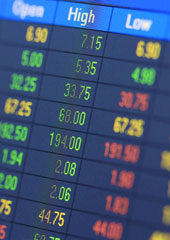U.S. Stock Ownership: Who Owns? Who Benefits?
What percentage of Americans actually owns stock?
September 19, 2013

The U.S. economy is still underperforming, but stock markets, fueled by the U.S. Fed, keep rising — to record highs. While the U.S. job market is still far from a full recovery, at least stock prices are giving Americans reason to cheer. Or do they?
We wonder: What percentage of Americans actually owns stock?
[toggle title_open=”A. 35% is not correct” title_closed=”A. 35%”]
More than 35% of all Americans own at least some stock, including that in retirement accounts or mutual funds. However, stock ownership is distributed quite unevenly throughout American society.
According to economist Edward N. Wolff at New York University, the wealthiest 1% of all Americans owned 35% of all the stock owned by U.S. households in 2010, a percentage that, due to recent market developments, is likely to have increased to as much as 38% today.
As of 2010, the richest 5% of U.S. households owned about two-thirds of all outstanding stock, a number that is likely as high as 70% today.[/toggle]
[toggle title_open=”B. 47% is correct” title_closed=”B. 47%”]
47% of all American own any stock at all — with an emphasis on “any.” Coincidentally, that is the very same number cited by 2012 Republican presidential candidate Mitt Romney as the percentage of Americans who pay no income tax.
That fewer than half of U.S. households own any stock at all shows that the ambition of the Reagan and Clinton administrations to turn Americans into a nation of shareholders has fallen significantly short of the goal.
In addition, nearly 44% of Americans lack a financial safety net, defined as not having enough savings or other liquid assets to stay out of poverty for more than three months if they lose their income, according to the Corporation for Enterprise Development. And one-third of all Americans do not have any savings at all.
These numbers, along with a trend (which picked up speed in the 1980s) from employer-funded pensions to self-funded retirement plans such as 401(k) plans and IRAs, make plain that more than half of the country’s population is entirely dependent on Social Security for their retirement.[/toggle]
[toggle title_open=”C. 53% is not correct” title_closed=”C. 53%”]
53% of Americans — or just over half the population — do not own any stock at all. This means that the current stock market rally can, even under the rosiest of circumstances, directly benefit less than half of the U.S. population.
However, since stock ownership is heavily concentrated among the wealthiest Americans, those who really benefit from a rising stock market are surprisingly small in number. As of 2010, only one-third of U.S. households owned stock portfolios worth at least $5,000 — and only 20% of households owned shares worth more than $25,000.
Slightly over half (50.3%, to be exact) of all stock is owned by U.S. households that have annual incomes of more than $250,000 — and over 75% is owned by households that earn more than $100,000 a year.[/toggle]
[toggle title_open=”D. 80% is not correct” title_closed=”D. 80%”]
The wealthiest 10% of all Americans own 81% of all shares of stock owned by U.S. households (as of 2010). This underscores just how concentrated financial wealth is in the United States.
Stock ownership falls precipitously after this top strata. The bottom 90% of U.S. households own 19% of the stock traded on U.S. markets — and the bottom 80% own less than half of that (8.4%). The bottom 60% of U.S. households own a mere 2.5% of outstanding shares.[/toggle]
Takeaways
Only one-third of US households owned stock portfolios worth at least $5,000, as of 2010.
The richest 5% of U.S. households owned about 2/3rds of all stock in 2010.
One-third of all Americans do not have any savings at all.
More than half of the U.S. population is entirely dependent on Social Security for their retirement.
Over 75% of all U.S. stock is owned by households that earn more than $100,000 a year.
The bottom 60% of U.S. households own a mere 2.5% of outstanding shares of stock.
Author
The Globalist
Read previous

After Lehman: How US Debt Exploded
September 18, 2013